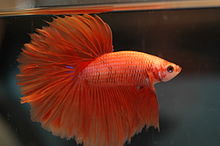Siamese fighting fish
| Siamese fighting fish | |
|---|---|
 |
|
| Selectively bred halfmoon male displaying his flared opercula. | |
| Scientific classification | |
| Kingdom: | Animalia |
| Phylum: | Chordata |
| Class: | Actinopterygii |
| Order: | Perciformes |
| Family: | Osphronemidae |
| Genus: | Betta |
| Species: | B. splendens |
| Binomial name | |
|
Betta splendens Regan, 1910 |
|
The Siamese fighting fish (Betta splendens), also sometimes colloquially known as the betta, is a species in the gourami family which is popular as an aquarium fish. They are a very territorial fish and it is unwise to house two males together. Even the females may become territorial towards each other if not housed in a large enough tank.
This species is native to the Mekong basin of Laos, Cambodia, Vietnam and Thailand. The fish can survive in many environments. The fish can be found in standing waters of canals, rice paddies and floodplains. It is listed as Vulnerable by the IUCN.
They are called pla-kad (biting fish) in Thai and trey krem in Khmer.
B. splendens usually grows to a length of about 6.5 cm (2.6 in). Although aquarium specimens are widely known for their brilliant colours and large, flowing fins, the natural coloration of B. splendens are generally dull green, brown and grey, and the fins of wild specimens are short. In captivity, they have been selectively bred to display a vibrant array of colors and tail types.
Betta splendens in the wild feed on zooplankton, crustaceans, and the larvae of mosquitoes and other water-bound insects. However, in captivity they can be fed a steady diet of pellets and frozen foods such as brine shrimp, bloodworms, daphnia and many others.
Despite myths that they will feed on any plant matter in the tank, they are naturally insectivores and would typically never eat vegetation as it is not natural for them to do so.
Male bettas will flare their gills, spread their fins and twist their bodies in a dance if interested in a female. If the female is also interested she will darken in colour and develop vertical lines known as breeding bars as a response. Males build bubble nests of various sizes and thicknesses at the surface of the water. Most tend to do this regularly even if there is no female present.
...
Wikipedia

